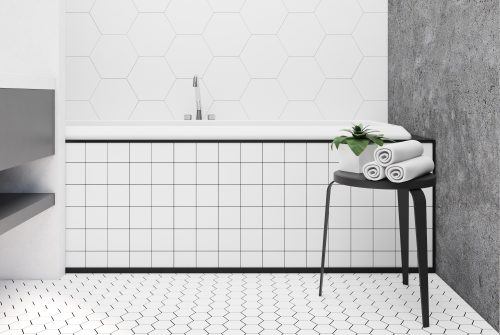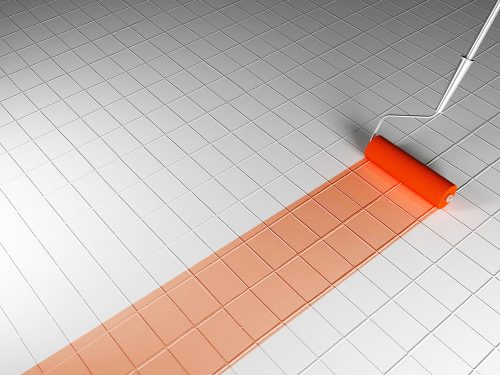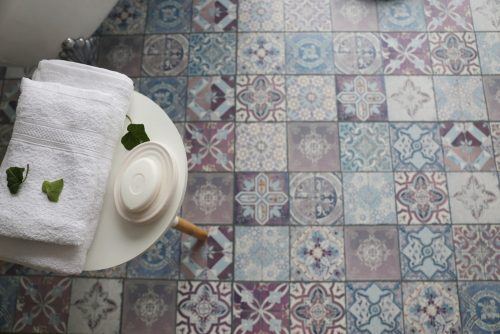The Best Tile Paints

If you’re thinking about remodeling your kitchen or bathroom but don’t want to spend a fortune, a great option to consider is painting your tiles. You can paint over the entire tiles’ surfaces while keeping them clean. In today’s post, we’ll show you how.
Tips for painting tiles
Tiles are normally flat pieces of clay that we use to decorate and protect our bathroom or kitchen walls. We can also use them for floors and outdoor areas (patios, balconies, terraces, etc.).
The biggest benefits of using tiles are: easy cleaning, preventing bacteria and germs from spreading, insulation, natural feel – and if we use tiles that have different finishes – decor.

If you want to paint your tiles, remember the important details: think about if you’ve painted your tiles before or if they already have layers of paint on them.
First things first, you have to eliminate any kind of residue that could be lingering on the tiles, especially the ones that you’ve used in your kitchen. By cleaning them properly, the paint will cover them more efficiently. If necessary, bleach the surface and wipe them off with a damp towel. Wait for them to dry before you paint on the first coat.
Tips for painting tiles
You have to consider your climate conditions as for this painting project, temperatures shouldn’t dip below 10ºC nor exceed 30ºC. In addition, humidity levels shouldn’t be higher than 75%.
Why? Tiles need apt conditions because they’re cold and heat conductors, meaning that they contract or expand depending on the temperature. Furthermore, if they’re damp or wet, paint won’t coat as well as it should and we’ll end up spending much more on our project than we originally planned. We’re talking about wasted effort and resources for a disappointing result.
We suggest doing a paint-adherence test before starting your project to make sure that you’ve chosen the right kind of paint for your tiles. Don’t forget to read the product label! Double check how much paint you have in your can as well: average paint cans can cover between 8 to 10 square meters per liter.

Once you’ve made sure that you have the right kind of paint, don’t apply too thick a coat. This will take a long time to dry and won’t look nice. If you think it’s necessary, wait until the next day to start the second coat.
Tile paints: which one to choose
Going beyond a prepared, clean tile surface, if we don’t choose the correct kind of paint, we won’t enjoy the results that we had in mind. The wrong kind of paint might not completely cover the surface, require layers and layers of paint or over time, the paint might even peel off. You can prevent these inconvenient situations by comparing the different tile paints available:
1. 2-stage paint
2-stage paint comes with two separate components, which need to be mixed right before painting on the first layer. This type of paint is very resilient and its finish is second-to-none. In addition, the results last for a long time.
However, 2-stage paint has a strong smell and is toxic. Consequently, you should paint your tiles with your doors and windows open in addition to using an adequate mask, plastic not paper, to paint.
2. Synthetic paint
Synthetic paint is the most popular paint choice and while it doesn’t offer quite a finish like 2-stage paint does, the results always look good. You’ll only need a paper mask if you use synthetic paint because it has a lower level of toxicity.

It dries within two hours, but you’ll need to wait six to eight hours before applying another coat. In light of the waiting time, we suggest starting bright and early with the first coat then applying the second in the afternoon.
3. Waterborne paint
Our third tile paint option isn’t always our strongest recommendation because it lasts for less time, peeling off faster than the others. However, sometimes this is easier to find than its synthetic or 2-stage counterparts.
Before allowing the painted area to get wet, you need to let the paint dry for at least 72 hours. This means that if you’re planning on painting your bathroom, you can’t use the shower for three days. It’ll sure be an inconvenience if you only have one bathroom!
If you’re thinking about remodeling your kitchen or bathroom but don’t want to spend a fortune, a great option to consider is painting your tiles. You can paint over the entire tiles’ surfaces while keeping them clean. In today’s post, we’ll show you how.
Tips for painting tiles
Tiles are normally flat pieces of clay that we use to decorate and protect our bathroom or kitchen walls. We can also use them for floors and outdoor areas (patios, balconies, terraces, etc.).
The biggest benefits of using tiles are: easy cleaning, preventing bacteria and germs from spreading, insulation, natural feel – and if we use tiles that have different finishes – decor.

If you want to paint your tiles, remember the important details: think about if you’ve painted your tiles before or if they already have layers of paint on them.
First things first, you have to eliminate any kind of residue that could be lingering on the tiles, especially the ones that you’ve used in your kitchen. By cleaning them properly, the paint will cover them more efficiently. If necessary, bleach the surface and wipe them off with a damp towel. Wait for them to dry before you paint on the first coat.
Tips for painting tiles
You have to consider your climate conditions as for this painting project, temperatures shouldn’t dip below 10ºC nor exceed 30ºC. In addition, humidity levels shouldn’t be higher than 75%.
Why? Tiles need apt conditions because they’re cold and heat conductors, meaning that they contract or expand depending on the temperature. Furthermore, if they’re damp or wet, paint won’t coat as well as it should and we’ll end up spending much more on our project than we originally planned. We’re talking about wasted effort and resources for a disappointing result.
We suggest doing a paint-adherence test before starting your project to make sure that you’ve chosen the right kind of paint for your tiles. Don’t forget to read the product label! Double check how much paint you have in your can as well: average paint cans can cover between 8 to 10 square meters per liter.

Once you’ve made sure that you have the right kind of paint, don’t apply too thick a coat. This will take a long time to dry and won’t look nice. If you think it’s necessary, wait until the next day to start the second coat.
Tile paints: which one to choose
Going beyond a prepared, clean tile surface, if we don’t choose the correct kind of paint, we won’t enjoy the results that we had in mind. The wrong kind of paint might not completely cover the surface, require layers and layers of paint or over time, the paint might even peel off. You can prevent these inconvenient situations by comparing the different tile paints available:
1. 2-stage paint
2-stage paint comes with two separate components, which need to be mixed right before painting on the first layer. This type of paint is very resilient and its finish is second-to-none. In addition, the results last for a long time.
However, 2-stage paint has a strong smell and is toxic. Consequently, you should paint your tiles with your doors and windows open in addition to using an adequate mask, plastic not paper, to paint.
2. Synthetic paint
Synthetic paint is the most popular paint choice and while it doesn’t offer quite a finish like 2-stage paint does, the results always look good. You’ll only need a paper mask if you use synthetic paint because it has a lower level of toxicity.

It dries within two hours, but you’ll need to wait six to eight hours before applying another coat. In light of the waiting time, we suggest starting bright and early with the first coat then applying the second in the afternoon.
3. Waterborne paint
Our third tile paint option isn’t always our strongest recommendation because it lasts for less time, peeling off faster than the others. However, sometimes this is easier to find than its synthetic or 2-stage counterparts.
Before allowing the painted area to get wet, you need to let the paint dry for at least 72 hours. This means that if you’re planning on painting your bathroom, you can’t use the shower for three days. It’ll sure be an inconvenience if you only have one bathroom!







